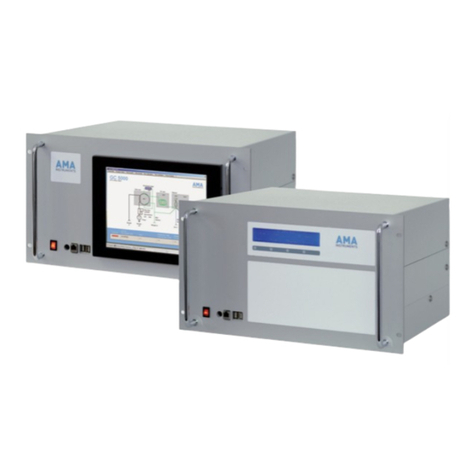
Operating Manual GC 5000; Version 6 English – Date 05/2014 2
Page
7.0 Starting operation …..…………………………………………………………..… 37
7.1 How to start measurement…………………………………………………………. 37
7.2 How to adjust the retention time windows………………………………………… 41
7.3 How to stop measurements ………………..……………………………………… 43
8.0 Calibrating and validating ..……………………………………………………… 44
8.1 Calibration ..…………………..……………………………………………………... 44
8.1.1 Calibration intervals .……..………………………………………………….……… 44
8.1.2 Calibration setup ……………………………………………..……………….…….. 44
8.1.3 How to start a calibration…………………………….……………………………... 46
8.1.4 Check the results of the calibration ………………………………………………. 50
8.2 Validation………………………..……………………………………………………. 54
8.2.1 Principle of validation ..…..…………………………………………………………. 54
8.2.2 Types of validation ..…………………………….………………………………….. 54
8.2.3 Validation setup …………………………………….………………………………. 55
8.2.4 How to start validation .…………………………….………………………………. 57
8.2.5 Check the validation status .……………………….………………………………. 58
9.0 Time program ……………....……………………………………………………… 59
9.1 How to setup the time program .…………………………………………………... 59
9.2 How to start the time program .…………………………………………….……… 60
10.0 Functional description ..…………………………………………………………. 62
10.1 Measuring principle BTX……..…….………………………………………………. 62
10.2 Measuring principle VOC…..………………………………………………………. 63
10.3 Measuring principle Process………………………………………………………. 65
11.0 Maintenance ………………………………………………………………………... 66
11.1 Security instructions ………………………………………………………………… 66
11.2 Maintenance schedule ……………………………………………………………... 67
11.3 Maintenance work …………………………………………………………………... 68
11.3.1 Exchange the enrichment tube (BTX) ……………………………………………. 68
11.3.2 Maintenance of the pump ………………………………………………………….. 69
11.3.3 Exchange the input filter of the MFC ……………………………………………… 69
11.3.4 Exchange or repair the capillary column ………………………………............... 70
11.3.5 Adjust the detector signal ………………………………………………………….. 72
11.3.6 Adjust the ignition voltage ………………………………………………………….. 72
11.3.7 Check the glow plug ………………………………………………………………… 72
11.3.8 Check the thermocouples ………………………………………………………….. 73
11.3.9 Check the heating units of detector and valve oven ……………………………. 73
11.3.10 Exchange of the PID lamp ………………………………………………............... 74
11.3.11 Clean the PID lamp window ………………………………….……………………. 75
11.3.12 Exchange the rotor of the rotary valve …………………………………………… 75
11.3.13 Exchange the GC oven motor …………………………………………………….. 77
11.3.14 Exchange the back panel fan ……………………………………………..………. 77
11.3.15 Exchange the Peltier cooler fan (BTX) …………………………………………… 78
11.3.16 FID maintenance …………………………………………………………............... 78
11.3.17 Exchange the enrichment or focusing tube (VOC) ..……………………………. 79
11.3.18 Exchange the Peltier cooler fan (VOC) ...………………………………………… 80
12.0 Troubleshooting …………………………………………………………………… 81
12.1 General faults ……………………………………………………………………….. 81
12.2 Error messages ..……………………………………………………………………. 82
12.3 Warning messages………………………………………………………………….. 86




























